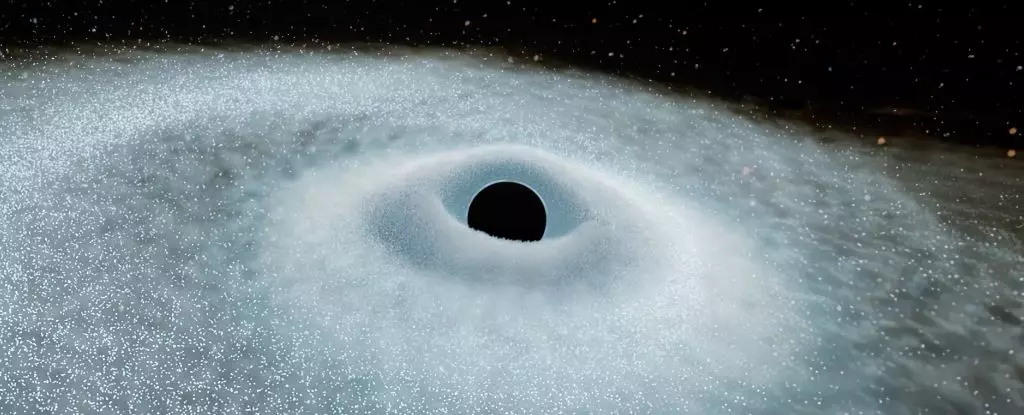In a groundbreaking revelation that transcends conventional astrophysics, the Gaia space telescope has inadvertently illuminated a never-before-seen form of cosmic explosion, dramatically amplifying our understanding of stellar deconstruction. Characterized as the most substantial outbursts since the Big Bang, these colossal bursts of energy, termed Extreme Nuclear Transients (ENTs), reveal a universe more dynamic and complex than previously imagined. The brilliance of these events surpasses the total energy output of 100 Suns, suggesting an uncharted territory of celestial phenomena waiting to be explored.
The discovery stems from Gaia’s mission to meticulously map the Milky Way, yet it has instead opened the door to observing distant galaxies undergoing extraordinary flares. This unforeseen objective has energized the astrophysics community, compelling experts to rethink existing paradigms surrounding black holes and their interactions with the stars that wander too close.
Understanding Tidal Disruption Events
Traditionally, when discussing the fate of a star as it nears a black hole, scientists employed the term tidal disruption event (TDE). This classification aptly captures the brutal process as gravitational forces rip a star apart, leading to a dramatic flash of light—the star’s last hurrah before succumbing to the black hole’s insatiable appetite.
In essence, when a celestial body ventures too close, it faces an irresistible tidal force that overwhelms its structural integrity. This results in a spectacular burst of light as the star disintegrates, with some material inevitably crossing the event horizon. Researchers have cataloged numerous TDEs over the years, but the newly identified ENTs significantly raise the stakes. These phenomena not only shine with an intensity elevating them far beyond typical TDEs, but they also have a prolonged luminous presence, lasting for years, in stark contrast to the more ephemeral nature of standard stellar demolitions.
Gaia’s Unexpected Findings
Amidst its cosmic cartography, the Gaia telescope stumbled upon two striking instances—Gaia16aaw and Gaia18cdj—that mirrored the properties of other extraordinary events. Characterized by unprecedented brightness, both occurrences challenge the established brightness norms and offer unique insights into how gargantuan black holes interact with nearby stars.
Astrophysicist Jason Hinkle of the University of Hawai’i’s Institute for Astronomy took a keen interest in these mysterious occurrences. His team analyzed the data and found that both fated events align perfectly with extreme stellar flares, only magnified to an astonishing degree. They not only shine brighter than the most brilliant supernova explosions but also hold an energy output that renders previous measures insignificant.
The captivating nickname ‘Scary Barbie’ given to a similar event (ZTF20abrbeie) illustrates the intriguing and somewhat light-hearted perspective scientists adopt in tackling the enormity of their discoveries. Yet beneath the playful moniker lies serious science, echoing the unfathomable scale at which these cosmic events occur.
A Shift in Cosmic Perspective
The discovery of ENTs necessitates a reevaluation of how astronomers interpret black holes and their growth mechanisms. Traditionally, supernovae were the most powerful explosions detectable across the cosmos. However, the emergence of ENTs raises questions about the ways in which supermassive black holes accumulate mass over time.
The rarity of these events—estimated to occur about ten million times less frequently than supernovae—adds another layer of intrigue. Their luminosity, enabling astronomers to observe them across vast cosmic distances, turns each observation into a visual time machine, allowing scientists to peer back into the universe’s history.
Benjamin Shappee, also from the Institute for Astronomy, resonates with the excitement surrounding these findings, noting that ENTs could revolutionize our understanding of black holes. The ability to observe these spectacular instances not only expands the tools available for astronomers but also engages a wider audience in the enigma of the universe.
A New Chapter in Astrophysics
The implications of this discovery extend beyond academic curiosity; they represent a paradigm shift in our comprehension of the cosmos. ENTs raise fundamental questions about the lifecycle of stars and the enigmatic forces shaping the universe. As scientists delve deeper into analyzing these extraordinary emissions of light and energy, we are beckoned to rethink not just black holes, but the entirety of astrophysical interactions.
Through the lens of our growing insight into ENTs, we stand on the brink of unraveling mysteries that could reshape our knowledge. The cosmos, with all its complexities and marvels, remains a relentless frontier for exploration. The existence of extreme nuclear transients is a clarion call for renewed curiosity and pursuit of understanding in the limitless vastness of space.

